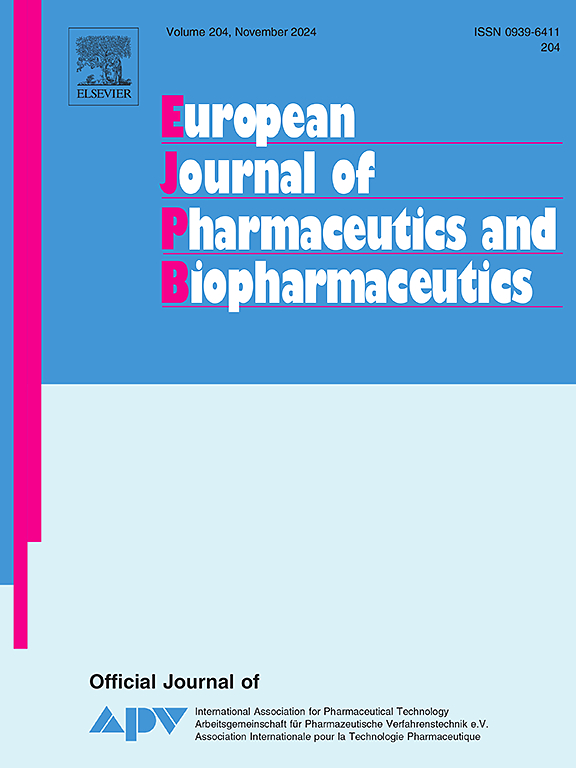热熔挤出-FDM 三维打印聚氧化乙烯片剂:溶胀和药物释放的溶解成像分析
IF 4.4
2区 医学
Q1 PHARMACOLOGY & PHARMACY
European Journal of Pharmaceutics and Biopharmaceutics
Pub Date : 2025-01-22
DOI:10.1016/j.ejpb.2025.114636
引用次数: 0
摘要
药物遗传学的最新发展强调了定制药物的重要性,推动了对定制药物递送的FDM 3d打印等技术的兴趣。FDM 3d打印是一种很有前途的技术,可以按需制造定制的口服剂型,在形状和大小、剂量和药物释放谱方面提供灵活性。本研究研究了使用PEO作为主要聚合物和PEG 6 K作为增塑剂的3d打印口服剂型的制造和表征。首先,利用热熔挤压技术考察了不同盐酸心得洛尔浓度的PEO长丝的可印刷性。考察了盐酸心得洛尔浓度对纤维力学性能的影响,然后考察了表面特性,包括粗糙度和润湿性。利用溶出度成像技术观察药物含量对peo基3d打印片剂溶胀和溶出特性的影响。结果表明,随着药物负荷的增加,纤维的弯曲应力降低。我们还观察到,增加药物负荷导致3d打印的PEO片的表面粗糙度增加,接触角降低,这意味着表面亲水性增加。随着药物浓度的增加,片剂的肿胀行为增加,导致更大的凝胶层形成。对比释药百分数,10 mg的心得安片释药率较高,说明药物含量越低释药速度越快。40 mg PPN片的凝胶层较大,起到扩散屏障的作用,阻碍了药物的释放,而10 mg PPN片的溶胀和凝胶形成较少,释放速度更快。这些发现表明药物含量在改变3d打印PEO片剂的表面性质、肿胀行为和药物释放特征方面的重要性。该研究还展示了3d打印剂型溶出度成像的新用途,为溶胀动力学和通道形成提供了有价值的定量和定性见解,以优化用于药物输送系统的3d打印片剂。本文章由计算机程序翻译,如有差异,请以英文原文为准。

Hot-melt extruded-FDM 3D-printed polyethylene oxide tablets: Dissolution imaging analysis of swelling and drug release
Recent developments in pharmacogenetics have emphasised the importance of customised medication, driving interest in technologies like FDM 3D-printing for tailored drug delivery. FDM 3D-printing is a promising technique for the on-demand manufacturing of customised oral dosage forms, providing flexibility in terms of shape and size, dose and drug release profiles. This study investigates the fabrication and characterisation of 3D-printed oral dosage forms using PEO as the primary polymer and PEG 6 K as a plasticiser. Firstly, the printability of the PEO filaments with different propranolol hydrochloride concentrations was explored using the hot-melt extrusion technology. The influence of the propranolol hydrochloride concentrations on the mechanical properties of the filaments was examined was then examined after which surface characteristics, including roughness and wettability, were evaluated. Dissolution imaging was used to visualise the effects of drug content on the swelling and dissolution characteristics of the PEO-based 3D-printed tablets. Results showed a reduction in the flexural stress of the filaments with increasing drug load. It was also observed that increasing the drug load led to higher surface roughness and lower contact angles of the 3D-printed PEO tablets, implying increased surface hydrophilicity. The swelling behaviour of the tablets increased with higher drug concentrations, resulting in a larger gel layer formation. When comparing the drug release percentages, the release rate was higher in the 10 mg propranolol tablets, suggesting that a lower drug content led to a faster release. The greater gel layer of the 40 mg PPN tablets hindered the drug release by acting as a diffusion barrier, while the 10 mg PPN tablets, with less swelling and gel formation, experienced a faster drug release. These findings show the importance of drug content in modifying the surface properties, swelling behaviour, and drug release profiles of 3D-printed PEO tablets. The study also demonstrates the novel use of dissolution imaging for 3D-printed dosage forms, providing valuable quantitative and qualitative insights into swelling dynamics and channel formation to optimise 3D-printed tablets for drug delivery systems.
求助全文
通过发布文献求助,成功后即可免费获取论文全文。
去求助
来源期刊
CiteScore
8.80
自引率
4.10%
发文量
211
审稿时长
36 days
期刊介绍:
The European Journal of Pharmaceutics and Biopharmaceutics provides a medium for the publication of novel, innovative and hypothesis-driven research from the areas of Pharmaceutics and Biopharmaceutics.
Topics covered include for example:
Design and development of drug delivery systems for pharmaceuticals and biopharmaceuticals (small molecules, proteins, nucleic acids)
Aspects of manufacturing process design
Biomedical aspects of drug product design
Strategies and formulations for controlled drug transport across biological barriers
Physicochemical aspects of drug product development
Novel excipients for drug product design
Drug delivery and controlled release systems for systemic and local applications
Nanomaterials for therapeutic and diagnostic purposes
Advanced therapy medicinal products
Medical devices supporting a distinct pharmacological effect.

 求助内容:
求助内容: 应助结果提醒方式:
应助结果提醒方式:


